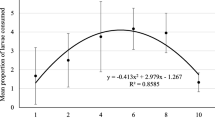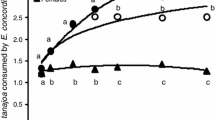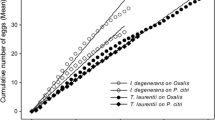Abstract.
The aims of this study were: (a) determine the prey stage preference of female Euseius hibisci (Chant) (Phytoseiidae) at constant densities of different stages of Tetranychus urticae Koch (Tetranychidae), (b) assess the functional response of the predator females to the varying densities of eggs, larvae, or protonymphs of T. urticae, and (c) estimate the functional response of E. hibisci when pollen of Ligustrum ovalifolium was present as well. We conducted experiments on excised pieces of strawberry leaf arenas (Fragaria ananassa) under laboratory conditions of 25 ± 2 °C, 60 ± 5% RH and 12 h photophase. Our results indicated that the predator consumed significantly more prey eggs than other prey stages. Consumption of prey deutonymphs and adults was so low that they were excluded from the non-choice functional response experiments. The functional response on all food items was of type II. The two parameters of the functional response were estimated for each prey type by means of the adjusted non-linear regression model. The highest estimated value a′ (instantaneous rate of discovery) and the lowest value of Th (handling time, including digestion) were found for the predator feeding on prey eggs, and a′ was lowest and Th highest when fed protonymphs. Using the jack-knife method, the values for the functional response parameters were estimated. The values of a′ and Th produced by the model were similar among all prey types except for the eggs, which were different. Using pollen simultaneously with prey larvae decreased the consumption of the latter over the full range of prey densities The suitability of this predator for biological control of T. urticae on strawberry is discussed.
Similar content being viewed by others
References
M.H. Badii A.E. Flores (1990) ArticleTitleEcological studies on mites in citrus in Nuevo Leon, Mexico: preliminary surveys for phytoseiids Int. J. Acarol. 16 235–239
M.H. Badii A.E. Flores G. Ponce (2000) Control biológico de arañas rojas M.H. Badii A.E. Flores L. Galán-Wong (Eds) Fundamentos y Perspectivas de Control Biológico UANL Press Monterrey 255–282
M.H. Badii A.E. Flores G. Ponce R. Torres S. Varela H. Quiróz (2002) Especies selectas de Phytoseiidae y su liberación en campo P. Valenzuela M. Martínez R. Báez (Eds) Técnicas de liberación de entomófagos y aplicación de entornopatógenos SMCB Hermosillo 25–35
M.H. Badii J.A. McMurtry (1988) ArticleTitleEffect of prey density on functional and reproductive responses of the predatory mite Phytoseiulus longipes (Acari: Phytoseiidae) Int. J. Acarol. 14 61–69
M.H. Badii J.A. McMurtry A.E. Flores (1999) ArticleTitleRates of developmentsurvival and predation of immature stages of Phytoseiulus longipes (Acari: Mesostigmata: Phytoseiidae) Exp. Appl. Acarol. 23 611–621
M. Benuzzi G. Manzaroli G. Nicoli (1992) ArticleTitleBiological control in protected strawberry in northern Italy Bull. OEPP/EPPO Bull. 22 445–448
B.D. Congdon J.A. McMurtry (1988) ArticleTitlePrey selectivity in Euseius tularencis (Acari: Phytoseiidae) Entomophaga 33 281–288
L.B. Coop B.A. Croft (1995) ArticleTitleNeoseiulus fallacis: dispersal and biological control of Tetranychus urticae following minimal inoculations into a strawberry field Exp. Appl. Acarol. 19 31–43
G.C. Decou (1994) ArticleTitleBiological control of the two-spotted spider mite (Acarina: Tetranychidae) on commercial strawberries in Florida with Phytoseiulus persimilis (Acarina: phytoseiidae) Fla. Entomol. 77 22–41
M.A. Easterbrook (1992) ArticleTitleThe possibilities for control of two-spotted spider mite Tetranychus urticae on field-grown strawberries in the UK by predatory mites Biocontr. Sci. Technol. 2 235–245
Y.Q. Fan F.L. Petitt (1994) ArticleTitleFunctional response of Neoseiulus barkeri on two-spotted spider mite (Acari: Tetranychidae) Exp. Appl. Acarol. 18 IssueID10 613–621
Garcia D.R. 1990. Fitoseidos (Acari: Phytoseiidae) en fresa (Fragaria sp.) del Municipio de Irapuato, Guanajuato. B.S. Thesis. Escuela Agronomia y Zootecnia, Ex-Hacienda “El Copal”, Irapuato, Guanajuato, Mexico
F. Garcia-Mari J.E. Gonzalez-Zamora (1999) ArticleTitleBiological control of Tetranychus urticae (Acari: Tetranychidae) with naturally occurring predators in strawberry plantings in ValenciaSpain Exp. Appl. Acarol. 23 IssueID6 487–495
C.B. Huffaker S.J. Simmonds J.E. Laing (1976) The theoretical and empirical basis of biological control C.B. Huffaker P.S. Messenger (Eds) Theory and Practice of Biological Control Academic Press New York 41–78
S.A. Juliano F.M. Williams (1987) ArticleTitleA comparison of methods for estimating the functional response parameters of the random predator equation J. Anim. Ecol. 56 641–653
J. Landeros S. Rodriguez M.H. Badii P.A. Cerda A.E. Flores (2001) ArticleTitleFunctional response and population parameters of Phytoseiulus persimilis Athias-Henriot on Tetranychus urticae Koch Southwestern Entomol. 26 IssueID3 253–257
T.P. Livdahl A.E. Stiven (1983) ArticleTitleStatistical difficulties in the analysis of predator functional response data Can. Entomol. 115 1365–1370
J.A. McMurtry (1985a) Avocado W. Helle M.W. Sabelis (Eds) Spider Mites, Their Biology, Natural Enemies and Control Elsevier Amsterdam 327–332
J.A. McMurtry (1985b) Citrus W. Helle M.W. Sabelis (Eds) Spider Mites, Their Biology, Natural Enemies and Control Elsevier Amsterdam 339–347
J.A. McMurtry (1992) ArticleTitleDynamics and potential impact of ‘generalist’ phytoseiids in agroecosystems and possibilities of establishment of exotic species Exp. Appl. Acarol. 14 371–382
J.A. McMurtry B.A. Croft (1997) ArticleTitleLife-styles of phyloseiid mites and their roles in biological control Ann. Rev. Entomol. 42 291–321
J.A. McMurtry G.T. Scriveri (1964) ArticleTitleStudies on the feeding, reproduction and development of Amblyseius hibisci (Acarina: Phytoseiidae) on various food substances Ann. Entomol. Soc. Am. 57 649–655
E.R. Oatman M.E. Badgley G.R. Platner (1985) ArticleTitlePredators of the two-spotted spider mite on strawberry Calif. Agric. 29 9–12
M.H. Quenouille (1956) ArticleTitleNotes on bias in estimation Biometrika 43 353–360
D. Rogers (1972) ArticleTitleRandom search and insect population models J. Anim. Ecol. 41 369–383
M.W. Sabelis (1985) Predation by spicier mites W. Helle M.W. Sabelis (Eds) World Crop Pests. Spider Mites. Their Biology, Natural Enemies and Control Elsevier AmsterdamThe Netherlands 103–129
InstitutionalAuthorNameSAGARPA (2001) ArticleTitleProducción anual de hortalizas en México Boletín técnico número 12296 1–89
InstitutionalAuthorNameSAS Institute (1985) SAS User’s GuideVersion 5 edition SAS Institute Cary, NC
C.E.T. Shih C.J. Wang (2001) Functional response of Amblyseius ovalis (Evans) (Acari: Phytoseiidae) on Tetranychus urticae Koch (Prostigmata: Tetranychidae): effect of prey stages R.B. Halliday D.E. Walter H.C. Proctor R.A. Norton M.J. Colloff (Eds) Acarology: Proceedings of the 10th International Congress CSIRO Publishing Melbourne 498–505
L.K. Tanigoshi J. Fargerlund J.Y. Nishio-Wong H.J. Griffiths (1985) ArticleTitleBiological control of citrus thripsScirtothrips citriin southern California citrus groves Environ. Entomol. 14 733–741
L.K. Tanigoshi J.Y. Nishio-Wong (1982) ArticleTitleCitrus thrips. Biology, ecology and control USAD Tech. Bull. 1668 1–17
M. Wysoki (1985) Outdoor crops W. Helle M.W. Sabelis (Eds) World Crop Pests. Spider Mites. Their Biology, Natural Enemies and Control Elsevier Amsterdam 375–384
M. Zacharda M. Hluchy (1997) ArticleTitleBiological control of the two-spotted spider mite Tetranychus urticae on strawberries by the predatory phytoseiid mite Typhlodromus pyri (Acari: Tetranychidaephytoseiidae) Exp. App. Acarol. 21 IssueID2 83–94
Zar J.H. 1996. Biostatistical Analysis, 3rd ed. Upper Saddle RiverNJ
Z. Zhao J.A. McMurtry (1990) ArticleTitleDevelopment and reproduction of three Euseius (Acari: phytoseiidae) species in the presence and absence of supplementary foods Exp. Appl. Acarol. 8 233–242
Author information
Authors and Affiliations
Corresponding author
Rights and permissions
About this article
Cite this article
Badii, M.H., Hernández-Ortiz, E., Flores, A.E. et al. Prey stage preference and functional response of Euseius hibisci to Tetranychus urticae (Acari: Phytoseiidae, Tetranychidae). Exp Appl Acarol 34, 263–273 (2004). https://doi.org/10.1007/s10493-004-1180-8
Received:
Accepted:
Issue Date:
DOI: https://doi.org/10.1007/s10493-004-1180-8




